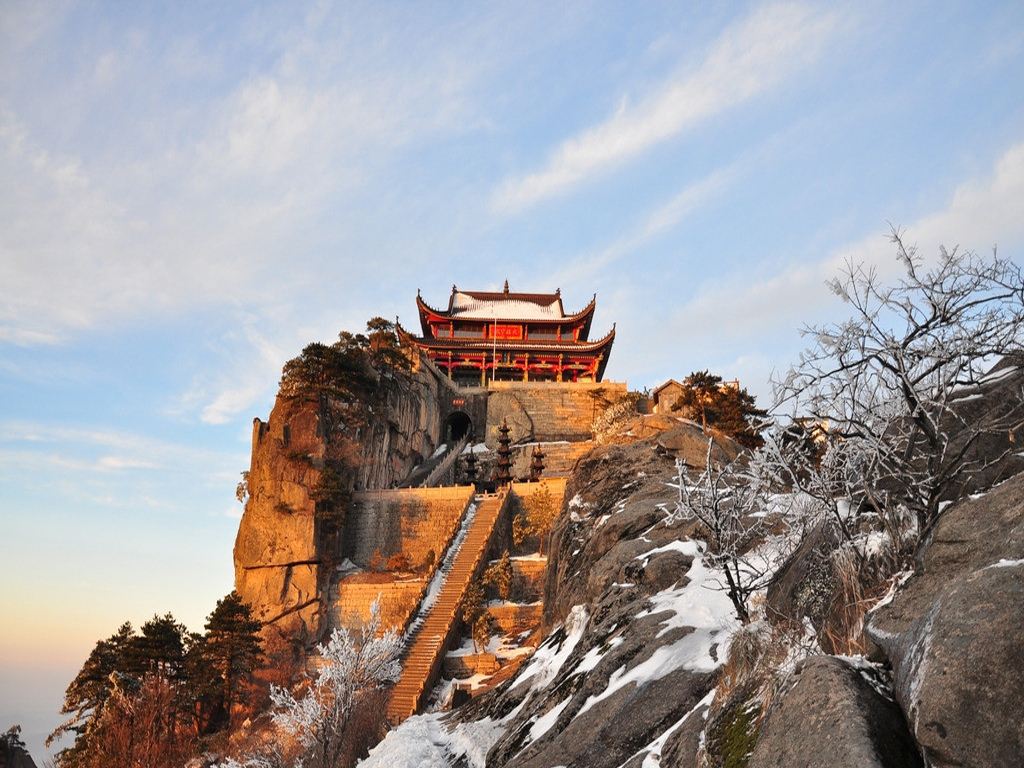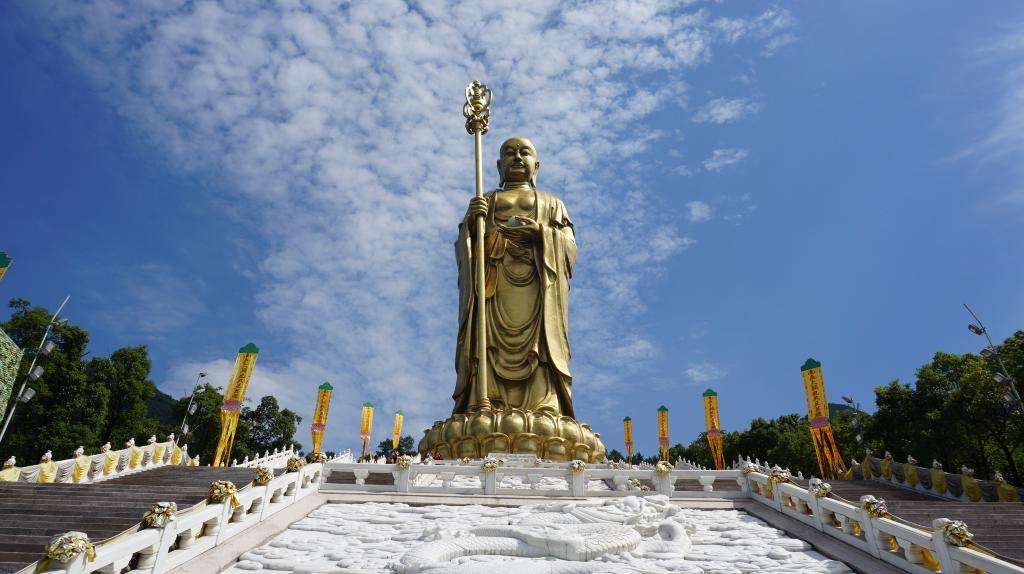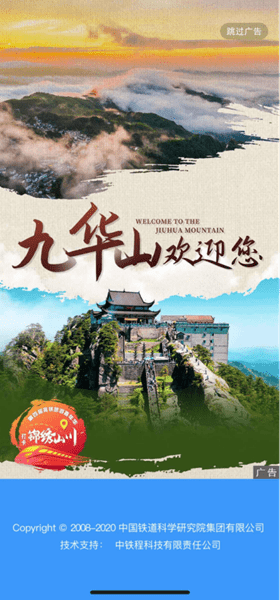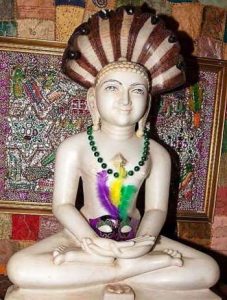Mount Jiuhua, translated as “Nine Glorious Mountains,” is one of the Four Great Sacred Peaks of Chinese Buddhism. It is a composite granitic massif located in Chizhou, Anhui Province. Formally classed as a UNESCO Global Geopark, Mount Jiuhua spans 139.7 square kilometers and has a peak elevation of 1,344.4 meters above sea level. Geoparks are defined as “single, unified geographical areas at which sites and landscapes of international geological significance are managed with a holistic concept of protection, education, and sustainable development.” (UNESCO) In principle, geoparks involve local communities partnering with an enlightened government policy of conservation and sustainable development. This coordinated approach is gaining momentum and popularity, particularly as its methodology unites multiple facets of flourishing, including the environmental, economic, and cultural.
Mount Jiuhua was formed by the collision of the Eurasian and Pacific tectonic plates, and is an example of high peaks and unusually formed rocks created by colossal fault-block landforms of granite. These granitic landforms emerge high above the subtropical vegetation and flora of the local environment, resulting in a striking “peak-hill-basin” complex. The abundant precipitation of Jiuhua is also a major source of water that feeds the Yangtze River system, one of China’s core drainage basins. The invaluable ecosystem and biodiversity of this massif has led to a centuries-long fascination with the geopark.
Mount Jiuhua has 99 peaks to its name, formed along 14 ridges. There are nine particularly famous peaks: Tiantai Peak (天台峰), Tianzhu Peak (天柱峰), Shiwang Peak (十王峰), Lianhua Peak (蓮花峰), Duxiu Peak (獨秀峰), Luohan Peak (羅漢峰), Wulao Peak (五老峰), Fuhu Peak (伏虎峰), and Furong Peak (芙蓉峰). There are 57 locations identified as being of “geological significance” on Mount Jiuhua, and it is host to many Buddhist temples. The mountain range is part of three mountain systems that includes the Huangshan and Tianmu ranges. Mount Jiuhua is listed by the Chinese government as a 5A-level tourist attraction and cultural heritage site. The 5A status is awarded by the Ministry of Culture and Tourism to only the most-important and best-maintained tourist attractions.
The government’s and geopark community’s approach toward Mount Jiuhua is twofold: promoting tourism and economic development, and preserving its unique geological environment. The site attracts some 8.5 million tourists per year, with related industries providing jobs for more than 15,000 people in the area. Mount Jiuhua reached a new high for visitor numbers in 2016, when 9.9 million visitors were recorded, bringing in 11.4 billion yuan (US$1.8 billion) in tourism revenue.
Apart from offering some of the most stunning mountain and forest scenery in China, Mount Jiuhua has a long and complex relationship with Buddhism. However, it took centuries for this area to not only become seen as a holy mountain, but specifically a sacred mountain of the Dharma.
The Buddhist history of Mount Jiuhua
Mount Jiuhua’s association with Buddhism has a complicated timeline. Until the Ming and Qing dynasties, it was more closely tied to foreign Buddhist figures. Its affiliation with the bodhisattva Kshitigarbha (Ch: Dizang Pusa) seems to have been a homegrown, local tradition, yet was, paradoxically, stimulated by Sino-Indian and Sino-Korean connections. According to the Mahayana tradition, Kshitigarbha is the savior of beings suffering in the hell realms. He is primarily known for his vow to guide all living beings in the six realms of suffering, or samsara.
The earliest claim by Buddhism to Mount Jiuhua ironically appears in a very recent text: the Chronicles of Anhui (Anhui tongzhi; 安徽通志). Compiled in 1877, during the reign of the Guangxu Emperor, the Chronicles of Anhui’s colophon 4, chapter 10 states: “In the fifth year of the era of Emperor An of Eastern Jin, Chan Master Beidu (杯渡) founded a temple on Jiuhua Mountain.” (Baidu) The fifth year of Emperor An corresponds to the Eastern Jin dynasty years 397–401 CE. The name Beidu seems to be a Sinicization of a non-Chinese name, which might correspond to the Central Asian, Indic, or otherwise ethnically non-Han Buddhist missionaries who trickled into China during the early medieval period.
Mount Jiuhua recedes into historical obscurity until the Tang dynasty (618–907) and the parallel era of the Korean Silla dynasty (57 BCE–935 CE), when a shadowy figure emerges: Kim Chijiang (705–803), (Sheng 2013, 124) who is most likely the Sillan prince Kim Gyo-gak (Ch: Jin Qiaojue). The princely Kim is said to have left his royal position and privileges, traveled from the Korean Peninsula to China, and become the monastic Kim, cultivating the Buddhadharma on Mount Jiuhua. After living there for 75 years, Kim passed away at the age of 99. But his corporeal body was said to have remained intact, with his disciples associating Kim’s miracle and even his physical appearance—which apparently resembled that of Kshitigarbha—with the bodhisattva himself. They accordingly built a pagoda in the Shenguan Ridge of Mount Jiuhua, and the peak soon became a place to hold rites for Kshitigarbha. (王, 2011, 71–73)
Subsequently, a literary group called the Jiuhua Poetry Society was formed that seems to have been active during the Song and Yuan dynasties. (Sheng 2013, 124) This group gathered to practice painting and calligraphy, recite poetry, and to appreciate natural landscapes. Their preoccupations seem to not have been related to Buddhism, but one idea that did percolate was the notion of Mount Jiuhua as a sacred peak. The legacy of the Jiuhua Poetry Society endures today: more than 20 academies devoted to Chinese culture and arts, from painting to poetry, have been established across Mount Jiuhua, such as the Taibai, Teng Zijing, and Yangming academies.
Mount Jiuhua’s elevation to one of the four great Buddhist mountains occurs well into the Ming dynasty (1368–1644), making this honor a relatively recent status. The notion of Mount Jiuhua as sacred came to prominence by the reign of the Wanli Emperor (1573–1620), when writers and editors such as Wang Yihuai, Sun Sui, and Cai Lishen produced gazetteers (difangzhi; 地方誌) about Mount Jiuhua’s sanctity. (Sheng 2013, 128) Furthermore, Tu Long (1543–1605), a writer who penned a preface for a gazetteer written in 1589, wrote of E’mei, Butuo, and Wutai as the domains of Samantabhadra, Avalokiteshvara, and Manjushri respectively. (Sheng 2013, 128) This is the first preface assigning the mountains decisively to the specific prime celestials. Later gazetteers would build on this idea of three great bodhisattva mountains, until the concept of “Four Great Sacred Peaks” had emerged by the High Qing period.
This idea of four sacred mountains, each inhabited by a bodhisattva, came to be combined by the Kangxi reign with the notion of Mount Jiuhua as ranking among specifically Buddhist-affiliated mountains. This was made categorically clear in the Nanhai Putuoshan zhi of 1698 by Qiu Lian (1644–1729): “. . . they [Avalokiteshvara, Manjushri, Samantabhadra, and Kshitigarbha] want sentient beings to have proper places in which to render respect. Therefore, Manjushri manifests his response bodies [nirmanakaya] at Mount Wutai, Samantabhadra at Mount E’mei, and Guanyin and Kshitigarbha at Mount Putuo and Jiuhua [respectively].” (Sheng 2013, 127–28)
The history of Mount Jiuhua is therefore a convoluted blend of retroactive histories written by authors working for imperial interests. This was eventually fused with the Chinese Buddhist longing for local pilgrimage and geographical localization. The result was, as part of the broader project of Sinicizing Buddhism, a new religious tradition completely unique to Anhui Province by the time of the Ming and Qing dynasties.
The sights and events of Mount Jiuhua
Mount Jiuhua’s dramatic, majestic scenery can be enjoyed from multiple angles thanks to its 99 peaks. Zooming in, the geopark has many areas that are worth days of exploration in themselves: from waterfalls and primeval caves to overhanging cliffs, clear pools, and ancient valleys. Many of the temples may only be visited by penetrating thick patches of dense, subtropical forest, which makes trekking in this area all the more rewarding and fascinating.
After Mount Jiuhua became a pilgrimage center for devotees of Kshitigarbha, monasteries on this mountain steadily increased in number. At its zenith, there were more than 300 Buddhist temples on Mount Jiuhua, with more than 4,000 monks and nuns residing there. (王, 2011, 73) Sadly, the Late Qing period suffered domestic crises such as natural disasters, government corruption, and economic catastrophe, along with foreign interference and invasion. It is hard to know how much heritage was lost due to potential looting, theft, and smuggling, and a lack of monastery maintenance and neglect. However, as noted earlier, the government now monitors the monastic, tourism, and environmental situation much more closely than in previous decades.
Fortunately, many temples and other Buddhist landmarks remain across the geopark. Some 3,000 nuns and monks reside in about 350 temples and monasteries, meaning that the majority of structures do not seem to have suffered total destruction over the past two centuries. The largest temple in the geopark is Qiyuansi, or Tending Garden Monastery. It was first built in the 16th century, during the Ming dynasty, and remodeled during the Qing dynasty. The aesthetic and cultural integration of Chinese Confucianism and Buddhism is demonstrated by the artistic and cultural establishments that flourished during the Chinese medieval period, and which endure today. Local residents maintain not only this connection, but the local structures’ Hui-style architecture and cuisine in the general area.
Pilgrims and tourists from around the world can visit Tiantai Peak on the birthday of Kshitigarbha, which falls on the 30th day of the seventh lunar month. The Jiuhua Temple Fair takes place during this period, with folk artists giving performances, and vendors selling souvenirs such as tourist cards and photographs of Mount Jiuhua. Temples and monasteries across the area hold Buddhist rituals and services, such as the “Bodhisattva Figure Consecration,” the “Temple Abbot Appointment”—subject to the schedules of the monastic communities residing there—and the “Land-water Dharma Assembly.” The shuilu fahui is one of Mahayana Buddhism’s largest and longest Dharma ceremonies and is used to raise funds for monastic institutions.
China’s efforts to invest more in the area’s conservation were rewarded by Mount Jiuhua’s inclusion on the UNESCO Global Geopark List in 2019. This list recognizes the international geological significance of Mount Jiuhua and its landscapes. It is the local government’s priority to develop a holistic approach to management, protection, and sustainable development.
After Mount Jiuhua was added to the UNESCO Global Geopark List, Zhang Yinhu of the Jiuhua Mountain Geological Park Office said: “The plans for Jiuhua Mountain have been included in the overall plan for the natural protection and social and economic development of Chizhou City, which administers the mountains. In addition, we have organized a team to protect geological relics.” (The State Council, The People’s Republic of China)
Mount Jiuhua was formed from millions of years of geological movements and formations that have resulted in the beautiful geopark that stands today. While the Buddhist connection emerged from relatively murky historical circumstances and a unique Sino-Korean connection, by the time of the Ming dynasty, Mount Jiuhua’s standing as a holy site and relationship to Kshitigarbha was separately established. Then, by the Qing, these two prestigious statuses were combined to make it one of Chinese Buddhism’s Four Great Sacred Peaks. Nowadays, its formal classification as a geopark is perhaps just as important, prioritizing ecological conservation and sustainable tourism alongside the preservation of local Chinese heritage and the Buddhist institutions that sanctify this unique locale.
References
Sheng Kai. 2013. “On the Veneration of the Four Sacred Buddhist Mountains in China.” In The Eastern Buddhist 44.2. 121–43.
熊武一;唐西清,柳才久,傅光明. 當代軍人辭典. 1988. A Dictionary for Modern Armymen. Beijing: 新華出版社.
孫書安. Shu’an Sun. 2000. 中国博物别名大辭典. 北京出版社: 新華書店.
王學信. 2011. “蓮花聖域九華山,” 書屋. 71–73.
See more
UNESCO Global Geoparks (UGGp) (UNESCO)
九华山 (Baidu)
TSP Web
Jiuhuashan Unesco Global Geopark (UNESCO)
Latest Geoparks Will Highlight Conservation (The State Council, The People’s Republic of China)
Related features from BDG
Ksitigarbha, Liveblogging from Hell















